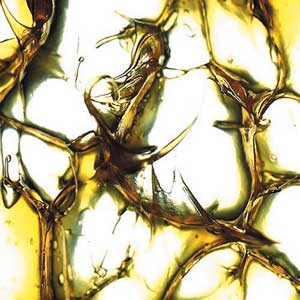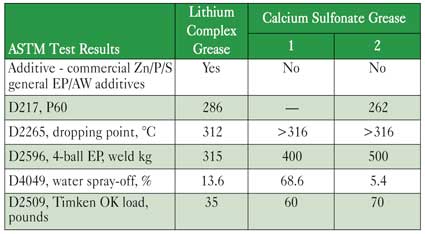Grease is grease, right? Unfortunately, the answer is n […]
Grease is grease, right? Unfortunately, the answer is not that simple, because there are many types of greases. If the right grease is not being used in equipment, you could be paying too much for replacement parts. On the other hand, the right grease can allow equipment to run for years without a maintenance problem. The key is learning which grease is right for your needs.
Calcium Sulfonate
Not new to the grease scene, calcium sulfonate thickeners have been around for almost 50 years. This particular type of grease has inherent extreme pressure (EP) properties that stand out from the rest. These properties, combined with the fact that it can be formulated for use in H-1 (food-grade) applications, make it an attractive alternative to other greases.
Background
There are a number of grease thickeners available, each with its own strengths and weaknesses. Briefly, typical lithium-based greases (the most common) are made from a fatty acid, usually 12-hydroxystearic acid, and a lithium base to produce a simple soap which acts as the grease thickener. Components are then added to give it EP and other desirable properties that allow equipment to run at peak performance.

Figure 1. Calcium Sulfonate Grease
To make a lithium-based complex grease, part of the fatty acid is replaced with another acid (usually a diacid), which makes the complex soap. This type of mixed soap structure has special properties that enable the grease to be heated to a higher temperature without losing its structure or oil separating from the thickener. This maximum temperature is referred to as the dropping point. The dropping point is critical because it is the point at which the grease reverts back to a liquid (the oil separates from the thickener). Calcium sulfonate-based greases have a higher dropping point, making them attractive for some high-temperature applications.
Calcium sulfonate greases are made by converting a fluid detergent that contains amorphous calcium carbonate to a grease containing calcite particles. Because of the calcite particles’ lubricating properties, performance additives containing sulfur, phosphorous or zinc may not be needed. This is why some calcium sulfonate-based greases are attractive to the food industry.
The Art of Making Grease
Max Born, a German mathematician and physicist, once said, “Science is not formal logic. It needs the free play of the mind in as great a degree as any other creative art.” Making a grease is no exception. With respect to calcium sulfonate greases, the art involves the process used to convert the detergent to grease. How one executes this can affect the EP performance and dropping point. There’s more to the art of making grease. There is a range of manufacturers, and sometimes the process used for one manufacturer’s equipment must be modified for another. Therefore, art also plays a role in the manufacturing process.
Concerns with Calcium Sulfonates
Although calcium sulfonate greases have desirable properties, an inhibiting factor is the cost. Calcite particles are the business end of making the product work, but reaching that point can be expensive. In addition, calcium sulfonate supply is limited, while costs are escalating. Plants are operating at capacity, and grease is not the only bidder. Calcium sulfonates are used in engine oil, metalworking, automatic transmission fluid, industrial and automotive gear oil additives as well as other applications. To complicate the situation, let’s compare the treat rates. Heavy-duty diesel applications require an approximate treat level of five percent. In grease applications, the treat levels spike to between 20 and 50 percent. That’s a big difference and a major reason for the high cost.
Another downside is their performance with respect to pumpability and water sprayoff. Pumpability is a concern that can be alleviated through proper base oil selection. In the ASTM D4049 sprayoff test, a thin layer of grease is placed on a panel and sprayed with water. After the test is completed, the percent of grease lost is calculated. Many calcium sulfonate greases typically show significant sprayoff.

Table 1. Test Results Comparing Lithium Complex Grease
to Calcium Sulfonate-based Greases.
Advantages and Applications
When would you want to use calcium sulfonate grease? When the benefit outweighs the cost. If an application has specific requirements that only this type of grease can meet, then it is worth the price. This grease excels in EP performance, as demonstrated in the ASTM D2596 four-ball EP test, and in the ASTM D2509 Timken test. Some formulas also excel in salt fog performance. Applications that fit this category include marine environments, suspension bridges, automotive or other applications exposed to salt conditions.
General applications for calcium sulfonate greases include automotive, agricultural, construction, food, industry, mining, paper manufacturing and steel mills. Specific automotive applications include chassis, ball joints, universal joints and wheel bearings. Industrial applications include continuous casters, conveyors, ball mills, crushers, off-shore and underwater applications.1
Calcium sulfonate greases are also used in motor-operated steam valves to control high-pressure steam. These steam valves are typically found in nuclear plants and thermal-generating stations. An article in NLGI Spokesman, July 20022, supports that the calcite particles, inherent in calcium sulfonate greases, make them a good choice for high-temperature applications.
Calcium sulfonate greases are generally beneficial for rust performance, with oxidation stability considered good or excellent. Rust inhibitors are surfactants that neutralize acids on the surface of metal. They can also make an oily surface, or barrier, to stop rust on the surface. Although the thickener can affect oxidation, it is often based on the oil’s quality.
In the case of the four-ball weld test, a weld of 315 kg, 400 kg or even higher is common with a calcium sulfonate grease. Calcite particles have been described as forming a wafer- or scale-like structure which creates shear planes that trap between the metal surfaces. This forms a sacrificial layer on the metal that is constantly sheared away. After all, it is better to shear the calcite particles than the metal on the equipment.
In summary, if the application requires H-1 approval, heat resistance or water tolerance, a properly manufactured calcium sulfonate grease that meets your needs may be worth the price.
References
Jeff St. Aubin. Calcium Sulfonate Grease. Chemtool Inc.
W. Mackwood, Crompton Co., and K. J. Brown, Utility Service Associates. Proper Grease Selection Reduces Steam Valve Maintenance.
To receive updates from Xin Gang, simply complete your details and let us know what you want to hear about.
